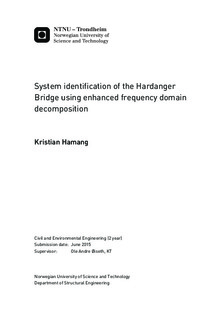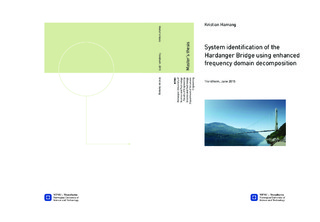| dc.description.abstract | The Norwegian Public Roads Administration is commissioned to investigate feasible alternatives to eight ferry crossings along E39, located on the western coast of Norway. The most challenging crossing is the Sognefjord, which is about 4 km wide and 1.3 km deep. Evaluation of existing civil engineering structures enables better predictions of concept structures that can meet the challenges regarding the E39 project.
This thesis aims to investigate how the modal parameters of the Hardanger Bridge changes for different mean wind velocities, using output measurements only. The modal parameters are extracted using frequency domain decomposition (FDD) and enhanced frequency domain decomposition (EFDD), implemented in MATLAB. The modal analysis is presented in detail to determine the validity of the estimated modal parameters.
A preliminary study is conducted on a proportionally damped, 4 degree of freedom shear frame, subjected to zero mean, Gaussian white noise. The dynamic system displays 4 separated modes in the frequency domain. All modal parameters are estimated with high accuracy using 2 hour response simulations.
15 modal parameters are determined for the Hardanger Bridge up to the second torsional mode. The modal parameters are categorized in three mean wind velocities; 2.98 m/s, 7.41 m/s and 15.75 m/s. The modal analysis gives reliable estimations of the mode shapes and corresponding natural frequencies. There is a large uncertainty of the the damping ratio estimates for closely spaced modes. The uncertainties regards extensive beating phenomenon in the correlation functions, leading to large variability in the estimation of the modal damping ratios.
All estimated mode shapes are complex, indicating a non-proportionally damped system. Several modes also show increasing complexity for an increase in mean wind velocity. An increase in modal damping ratios are also observed with increasing mean wind velocity, indicating the presence of aerodynamic damping. | |

